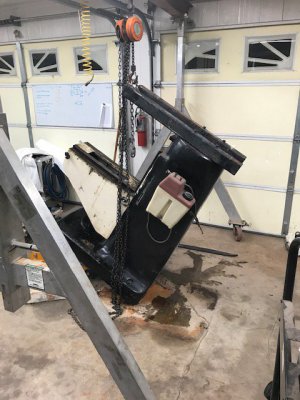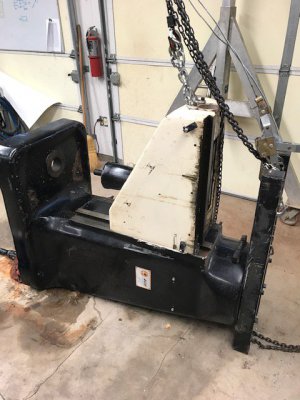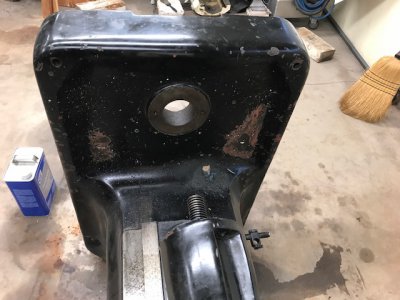I thought I would post my mistake so hopefully others could avoid this issue.
I was almost finished installing the Align servo on the z axis of my mill and was in the process of setting the position of the limit switches. I hand cranked the knee to the lowest position as I wanted the maximum clearance available, but when I tried to move the knee up with the hand crank it immediately jammed and would no longer move.
I could see the gib extending about an inch below the base of the knee, but unfortunately there was not enough room to use a hammer to tap on the bottom of the gib. I tried using a 36" pry bar but the gib would not budge.
A web search reveled that the only real solution would be to disassemble the mill, lay the base casting on it's back, drill a hole in the base to allow for a drift to be used directly on the bottom of the gib, fortunately heating the knee casting was not necessary in my case.
I drilled a 1" hole below the gib using a hole saw, I then wedged a wood 4 x 4 between the knee and the 3 x 3 x 1/4 steel tubes bolted in place of the turret. I used a 3/4 inch x 12" bronze bar as a drift punch, , a good friend bravely held the punch in contact with the gib while I gave it six strong blows with a 5 pound sledge hammer and on the sixth blow it came loose and with no damage to the tapered gib.
I'm a lucky happy man today,


I was almost finished installing the Align servo on the z axis of my mill and was in the process of setting the position of the limit switches. I hand cranked the knee to the lowest position as I wanted the maximum clearance available, but when I tried to move the knee up with the hand crank it immediately jammed and would no longer move.
I could see the gib extending about an inch below the base of the knee, but unfortunately there was not enough room to use a hammer to tap on the bottom of the gib. I tried using a 36" pry bar but the gib would not budge.
A web search reveled that the only real solution would be to disassemble the mill, lay the base casting on it's back, drill a hole in the base to allow for a drift to be used directly on the bottom of the gib, fortunately heating the knee casting was not necessary in my case.
I drilled a 1" hole below the gib using a hole saw, I then wedged a wood 4 x 4 between the knee and the 3 x 3 x 1/4 steel tubes bolted in place of the turret. I used a 3/4 inch x 12" bronze bar as a drift punch, , a good friend bravely held the punch in contact with the gib while I gave it six strong blows with a 5 pound sledge hammer and on the sixth blow it came loose and with no damage to the tapered gib.
I'm a lucky happy man today,



